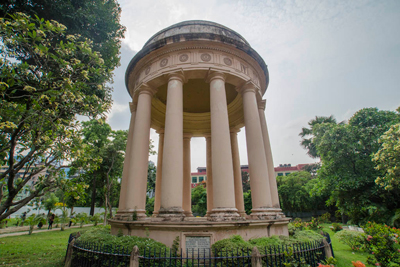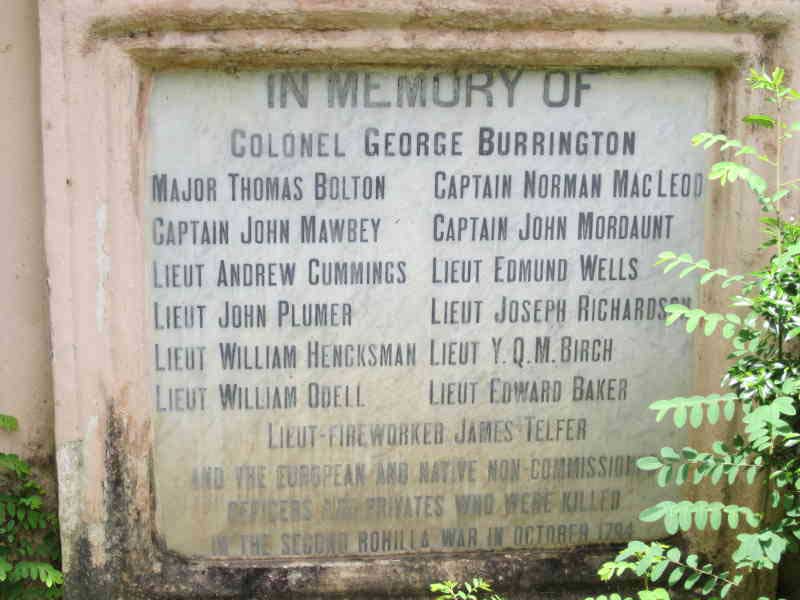
Located within the compound of St John’s Church, Calcutta, the Rohilla War Memorial Monument was built to commemorate the memory of the British soldiers, who lost their lives during the second Rohilla War in 1793.
The Rohillas were comprised of many warmonger tribes and sub-tribes of the Pathans, who were originated from the Pashtu roots of the mountainous regions of Afghanistan. The Mughal Emperor Aurangzeb inducted thousands of them in his army to fight against the Rajputs. The Rohillas were clever enough to take the opportunity and slowly took control of a large area where they were stationed, which included the present districts of Bareilly, Rampur and the neighbouring regions and renamed it as Rohilkhand. Gradually, many other members of the tribe started to migrate from Afghanistan to settle in and around the Katehar region. As they grew in number, they created a distinctly separate cultural, linguistic and a territorial identity of their own. After the death of Aurangzeb, as the Mughal Empire became weak, they declared independence and became a power to reckon with.

In the mean time, the Marathas became powerful and the Rohillas were being constantly threatened by them. The Rohillas, therefore, requested Shuja-ud-Daula, the Nawab of Awadh, to help them to fight against the Marathas. The Nawab promised to help the Rohillas, but in return demanded a sum of Rs. Forty lakh from the Rohillas. The Nawab, in his turn promised to help them in lieu of a hefty sum of Rs forty lakh. However, to fight against the Marathas, Shuja-ud-Daula sought the help of the British army. The British readily agreed to the proposal, as the Marathas were a threat for them also. Consequently, with the help of the British army, the Nawab fought against the Marathas and ousted them.
However, as the Rohillas refused to pay the promised money to Nawab Shuja-ud-Daulah after the end of the war, a war became inevitable between the Nawab and the Rohillas. This time, the Nawab again took the support of the British army and on 23 April 1774, the combined forces of the Nawab and the army of the East India Company, led by Colonel Alexander Champion faced the Rohillas, led by Hafiz Rahmat Ali Khan. In the consequent battle, Hafiz Rahmat Ali Khan was killed, the Rohillas were ousted to a place known as Miran Katra and the whole of Rohilkhand was annexed by Awadh. However, that was not the end of it. After the end of the battle, the treasury of the Rohillas was plundered and the ethnic cleansing by the Shia Shuja-ud-Daulah was unleashed. Consequently, thousands of villages were burned, women were raped and thousands of innocent men and women were slaughtered mercilessly.

The opportunist Sikhs took the advantage of the situation, as they attacked the weakened Rohillas and forced them to leave their villages. The helpless and cornered Rohilla population somehow managed to settle in small numbers wherever they could find asylum. Finally, The British created a small protected Rohilla state in Rampur and let the Rohilla chief Faizullah Khan continue as its Nawab.

But, the situation did not last long and after the death of Faizullah Khan in 1793, his ill-tempered sons began to contend with each other for the throne of Rampur. Finally, the Company was forced to intervene for maintaining peace and order in the area and General Abercromby led the British forces in the Second Rohilla War in 1794. The Rohillas were decisively defeated in the war and about 25.000 Rohilla soldiers were executed.

The comparatively small, but the beautiful Rohilla memorial monument was constructed by the British, following the end of the Rohilla War. The hemispherical roof of the 15 m tall memorial rests on twelve Doric pillars. After 101 years of the war, a plaque was fixed at the side of its base indicating the names of the fallen soldiers. The entire St. John’s Church Complex, including the Rohilla War Memorial Monument, is under the protection of the Archaeological Survey of India.
